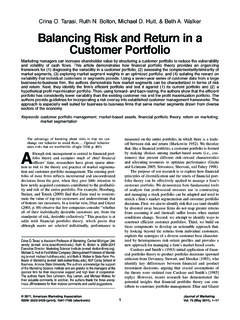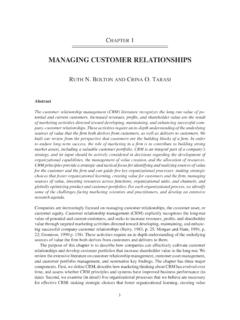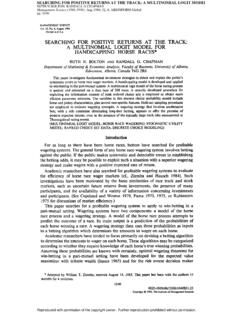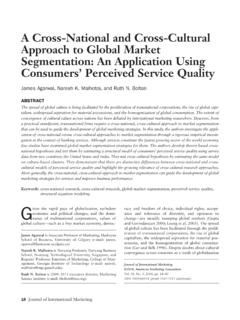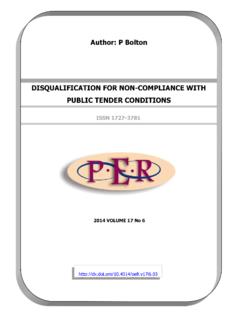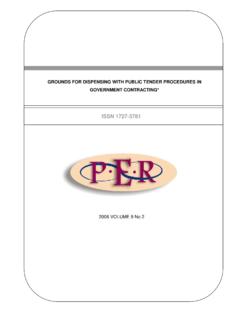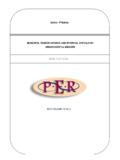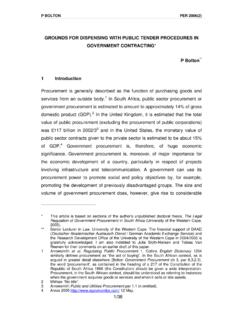Transcription of The Effect of Customers’ Emotional Responses to …
1 JOURNAL OF THE ACADEMY. Smith, bolton OF MARKETING. / SERVICE FAILURE. SCIENCE WINTER 2002. The Effect of Customers'. Emotional Responses to Service Failures on Their Recovery Effort Evaluations and Satisfaction Judgments Amy K. Smith George Washington University Ruth N. bolton University of Oklahoma This study examines the role of customer emotions in the relationship with the organization. Research by Berry and context of service failure and recovery encounters. It in- Parasuraman (1991) and Zeithaml, Berry, and vestigates how customers' Emotional Responses to service Parasuraman (1993) supports the notion that customers failures influence their satisfaction judgments after ac- are more emotionally involved in, and more observant of, counting for cognitive antecedents of satisfaction. The recovery service than routine or first-time service. While study also considers how customers' Emotional Responses some researchers have begun to investigate the impact of to service failures influence how they evaluate an organi- customers' affective state on their service evaluations zation's recovery efforts.
2 The research is conducted by sur- (Andreassen 2000; Dub and Maute 1996; Hui and Tse veying customers about their satisfaction judgments in two 1996; Taylor 1994) and on satisfaction processes (Mano service settings, restaurants and hotels. The results sug- and Oliver 1993; Oliver 1993; Westbrook and Oliver 1991;. gest that customers' Emotional Responses to service fail- Wirtz and Bateson 1999), no empirical studies have spe- ures will influence their recovery effort evaluations and cifically addressed how customers' Emotional Responses satisfaction judgments in some circumstances and that the to service failures influence their evaluations of various effects of emotion vary across industry settings. This study types of recovery efforts and their satisfaction with the ser- identifies the types of efforts that are most effective in help- vice encounter. ing customers recover from the negative emotions This gap in the current services marketing literature is caused by service failures.
3 Somewhat surprising given that consumer behavior research has shown that individuals use different informa- tion-processing strategies depending on their Emotional state ( , Bless, Bohner, Schwarz, and Strack 1990; Isen Service failure and recovery encounters represent criti- 1987; Mackie and Worth 1989; Schwarz and Bless 1991). cal moments of truth for organizations in their efforts to These studies suggest that both the amount and type of satisfy and keep customers. These encounters may also be information processing that customers engage in during a pivotal moments for customers, many of whom experience service encounter will vary based on their Emotional strong Emotional reactions in response to service failures Responses and will consequently influence their evalua- and subsequently decide whether to continue their tions. Therefore, it also seems likely that customers' satis- faction will be influenced by their Emotional Responses to Journal of the Academy of Marketing Science.
4 Service failures and that they may respond differently to Volume 30, No. 1, page 5-23. various types of recovery efforts ( , compensation, Copyright 2002 by Academy of Marketing Science. apology, etc.) depending on their Emotional state. 6 JOURNAL OF THE ACADEMY OF MARKETING SCIENCE WINTER 2002. FIGURE 1. Effects of Customers' Emotional Responses to Service Failures on Their Recovery Effort Evaluations and Satisfaction Judgments Emotional . response . (Negative Emotion, (In (Ma No Emotion) ter in Ef act fects ion : H1. Eff & H4). ect s: H2. &. H3. ). SERVICE SERVICE. RECOVERY SATISFACTION. FAILURE (Service Encounter, (Type and (Initiation, Apology, Speed, Cumulative). Magnitude). Compensation). Performance COGNITIVE. ANTECEDENTS. (Expectations, Disconfirmation, Justice NOTE: Arrows with broken pattern denote the relationships that are the focus of this study. Arrows with solid pattern denote relationships established in prior research.)
5 Emotional Responses are triggered by the service failure as denoted by the bold arrow and are measured after the service failure but prior to service recovery. Service failure performance has been shown in prior research to affect satisfaction (arrow not shown). Tests are conducted to determine whether interaction effects involve pure or quasi-moderation. This study examines the role of customer emotions in reviews the relevant literature and provides a conceptual the context of service failure and recovery encounters. It framework for the study. Next, we describe the research investigates the following research questions: design. Then, we develop a statistical model of how cus- tomers' Emotional Responses to service failures influence Do customers' Emotional Responses to service fail- their evaluations of the organization's recovery efforts and ures influence their service encounter satisfaction? their satisfaction with the service encounter.
6 Finally, we If so, how? That is, do Emotional Responses operate discuss the study results and outline the managerial impli- directly or indirectly? Are they pure or quasi-moder- cations and directions for future research. ators? Do customers' Emotional Responses to service fail- REVIEW AND CONCEPTUAL FRAMEWORK. ures influence how they process and weigh the or- ganization's recovery efforts? This section describes a framework for examining the Do customers' Emotional Responses to service fail- role of emotion in customers'satisfaction with service fail- ures also influence their overall (cumulative) satis- ure and recovery encounters and develops a set of testable faction judgments? hypotheses. The conceptual framework includes both cog- nitive and Emotional antecedents to customers' satisfac- In this study, we develop and estimate a statistical tion with service failure and recovery encounters, as illus- model of the effects of emotion on service encounter satis- trated in Figure 1.
7 We make a general prediction faction after accounting for cognitive antecedents of satis- (Proposition 1) that emotion will influence the formation faction ( , performance, disconfirmation, and justice). of customers' transaction-specific satisfaction judgments. The results provide insights regarding the role of emotions Then, we develop four hypotheses. The first two hypothe- in customer satisfaction with service failure and recovery. ses predict how emotion will influence service encounter They also provide guidance to managers about how orga- ( , transaction-specific) satisfaction that is, either nizations can effectively recover from the negative emo- directly (via a main Effect ) and/or indirectly (via tions caused by service failures. The following section Smith, bolton / SERVICE FAILURE 7. interaction effects with cognitive antecedents). The third to be no generally agreed-upon definition among market- hypothesis describes how emotion will moderate the ing scholars, Bagozzi, Gopinath, and Nyer (1999) have effects of the organization's service recovery effort.
8 The recently defined emotions as mental states of readiness fourth hypothesis concerns the influence of emotion on that arise from cognitive appraisals of events or one's own customers' overall ( , cumulative) satisfaction thoughts. Bagozzi et al. (1999) suggested that emotions judgments. typically have a specific referent ( , a customer is angered by inattentive service in a restaurant). Consistent Cognitive Antecedents to Satisfaction with Cohen and Areni (1991), they considered affect to be a general category for mental feeling processes that In the classic expectancy disconfirmation model, cus- includes emotions, moods, and (possibly) attitudes. Oliver tomer satisfaction with consumption experiences depends (1997) further pointed out that emotion tends to be more on expectations, performance, and disconfirmation (Chur- cognitively involved than affect (p. 294). Bagozzi et al. chill and Surprenant 1982; Oliver 1980; Oliver and (1999) distinguished emotions from moods in that moods DeSarbo 1988).
9 Social exchange theorists have identified tend to be lower in intensity than emotions, are generally three dimensions of perceived justice (fairness) that may nonintentional, do not have a specific referent, and are not also influence how customers evaluate consumption expe- as directly coupled with action tendencies as are emotions. riences: distributive justice, which involves resource allo- In this study, we investigate the influence of emotions cation and the perceived outcome of exchange (Adams arising from a specific referent, that is, a service failure. 1965; Deutsch 1975); procedural justice, which involves Service failures often evoke strong Emotional Responses the means by which decisions are made and conflicts are from customers. Prior research has shown that consumers'. resolved (Leventhal 1980; Lind and Tyler 1988; Thibaut affective response to service failures ( , emotions of be- and Walker 1975); and interactional justice, which ing irritated, angry, annoyed, etc.)
10 Will influence their ser- involves the manner in which information is exchanged vice evaluations (Dub and Maute 1996; Folkes, Koletsky, and outcomes are communicated (Bies and Moag 1986: and Graham 1987; Hui and Tse 1996; Taylor 1994). Bies and Shapiro 1987). Bagozzi et al. (1999) have observed that emotions often While Oliver and Swan (1989a, 1989b) considered the function in broad categories or amalgamated groupings . joint influence of disconfirmation and perceived justice on of positive and negative emotion/affect (p. 200). This customer satisfaction, they only addressed one aspect of study investigates the emotions provoked by service fail- perceived justice, namely, the distributive (equity) aspect. ures (which are undesirable), so it focuses on amalgam- Recently, researchers have begun to examine the influence ated groupings of negative emotions. Andreassen (1999). of all three types of perceived justice on customer satisfac- found that initial negative emotion triggered by a service tion and behavioral intentions after service failure and failure had a negative impact on customers' satisfaction recovery encounters ( , Blodgett, Hill, and Tax 1997; with the organization's complaint resolution efforts and Tax, Brown, and Chandrashekaran 1998).
